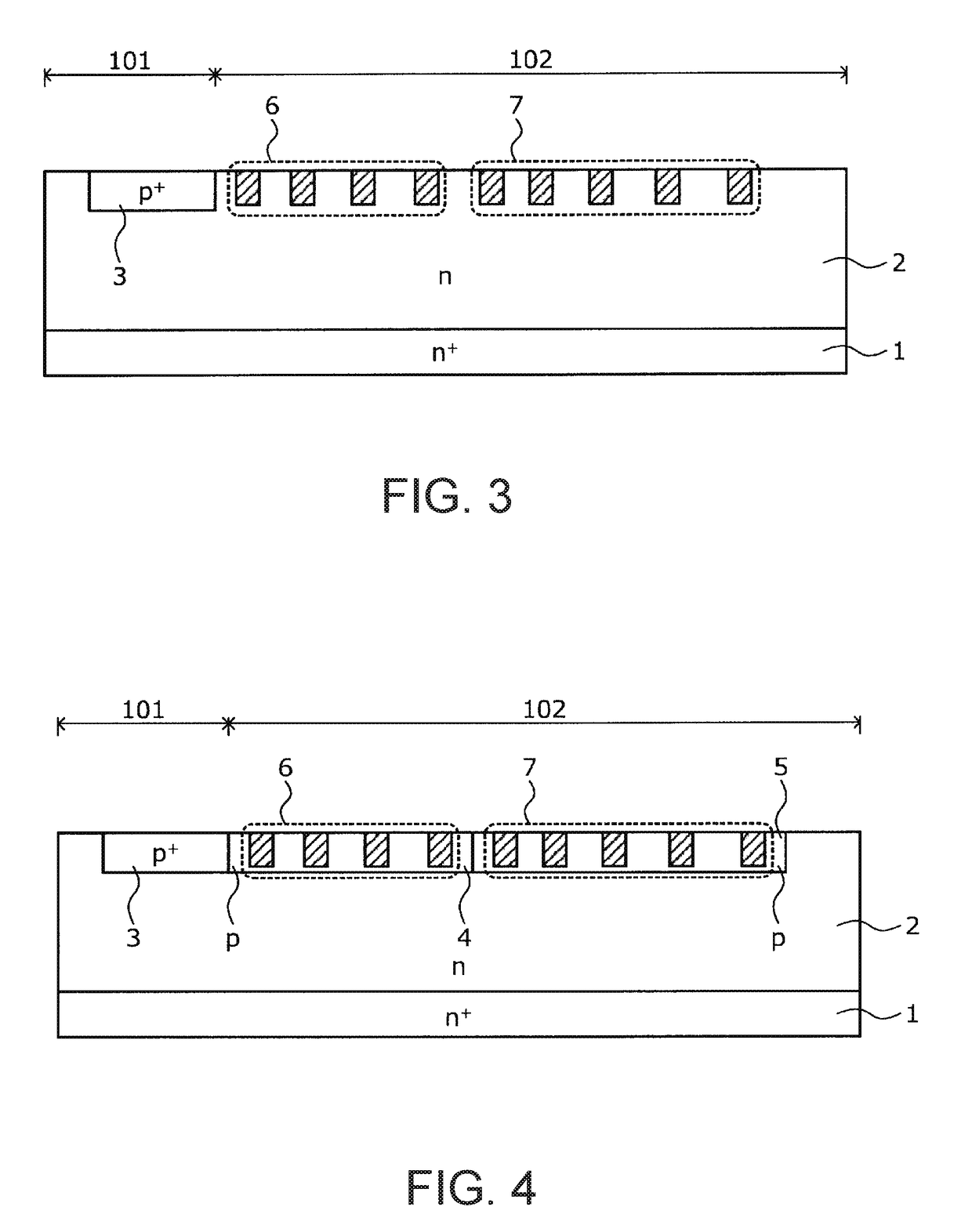Semiconductor device and method of manufacturing semiconductor device
a semiconductor and semiconductor technology, applied in the direction of semiconductor/solid-state device manufacturing, semiconductor devices, semiconductor devices, etc., can solve the problems of affecting device properties and complicated manufacturing steps, and achieve the effect of simplifying the number of manufacturing steps, simplifying the manufacturing steps, and affecting the properties of the devi
- Summary
- Abstract
- Description
- Claims
- Application Information
AI Technical Summary
Benefits of technology
Problems solved by technology
Method used
Image
Examples
embodiment 1
[0045]A semiconductor device in one aspect of the present invention is formed using a semiconductor with a wider bandgap than silicon (wide bandgap semiconductor). In Embodiment 1, a Schottky barrier diode (SBD) structure will be described as an example of a wide bandgap semiconductor such as a silicon carbide semiconductor device fabricated using silicon carbide (SiC).
[0046]FIG. 1 is a cross-sectional view of a configuration of a silicon carbide semiconductor device according to Embodiment 1. As shown in FIG. 1, the silicon carbide semiconductor device of Embodiment 1 has a n-type silicon carbide epitaxial layer (a semiconductor deposited film of a first conductivity type) 2 deposited on a first primary surface (front surface) of an n30 silicon carbide substrate (a semiconductor substrate of the first conductivity type) 1, such as the (0001) surface (Si surface).
[0047]The n+ silicon carbide substrate 1 is a single-crystal silicon carbide substrate. The n-type silicon carbide epita...
embodiment 2
[0067]FIG. 5 is a cross-sectional view of a configuration of a silicon carbide semiconductor device according to Embodiment 2. As shown in FIG. 5, in the silicon carbide semiconductor device of Embodiment 2, the width of the first region of the plurality of fourth p-type regions 7 from the active region 101, or namely, the width of the fourth p-type region 7a, which is closest to the active region 101, is greater than the width of the other fourth p-type regions 7. Furthermore, the fourth p-type region 7a is formed at the border between the first p-type region 4 and the second p-type region 5.
[0068]The other configurations of the silicon carbide semiconductor device of Embodiment 2 are similar to the configurations of the silicon carbide semiconductor device of Embodiment 1, and thus overlapping explanations will be omitted.
[0069](Method of Manufacturing Semiconductor Device of Embodiment 2)
[0070]Next, a method of manufacturing a semiconductor device according to Embodiment 2 will b...
embodiment 3
[0074]FIG. 6 is a cross-sectional view of a configuration of a silicon carbide semiconductor device according to Embodiment 3. As shown in FIG. 3, in Embodiment 3, the thickness of a portion 4a of the first p-type region 4 overlapping the third p-type region 6 is greater than other portions of the first p-type region 4. Furthermore, the thickness of a portion 5a of the second p-type region 5 overlapping the fourth p-type region 7 is greater than other portions of the second p-type region 5. In other words, the portion 4a in the first p-type region 4 overlapping the third p-type region 6 is deeper than other portions of the first p-type region 4. In addition, the portion 5a in the second p-type region 5 overlapping the fourth p-type region 7 is deeper than other portions of the second p-type region 5.
[0075]The other configurations of the silicon carbide semiconductor device of Embodiment 3 are similar to the configurations of the silicon carbide semiconductor device of Embodiment 1, ...
PUM
 Login to View More
Login to View More Abstract
Description
Claims
Application Information
 Login to View More
Login to View More - R&D
- Intellectual Property
- Life Sciences
- Materials
- Tech Scout
- Unparalleled Data Quality
- Higher Quality Content
- 60% Fewer Hallucinations
Browse by: Latest US Patents, China's latest patents, Technical Efficacy Thesaurus, Application Domain, Technology Topic, Popular Technical Reports.
© 2025 PatSnap. All rights reserved.Legal|Privacy policy|Modern Slavery Act Transparency Statement|Sitemap|About US| Contact US: help@patsnap.com



